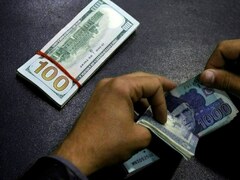EDITORIAL: Federal Finance Minister Muhammad Aurangzeb, on the sidelines of the World Economic Forum held annually at Davos, Switzerland, stated that Pakistan has agreed on a billion-dollar loan with two Mid-Eastern banks – one bilateral, which offers an independent, flexible and customized scheme and one trade (finance).
The amortization period of the loan is one year, and the rate of interest is 6 to 7 percent. Commercial banks typically lend at higher rates of interest yet the rate noted by Aurangzeb is comparable to what is applicable on China’s rollover debt and hence these are good terms, given the country’s current state of the economy.
Last fiscal year the government budgeted commercial loans at 1,305,000,000 million rupees but could secure only 285,000,000 or, in other words, only 22 percent of what was budgeted was realised from this source – a shortfall that without doubt led to greater reliance on domestic borrowing, which partly accounts for the rise in total mark-up on domestic debt from the budgeted 6,430,305 million rupees to the revised estimates of 7,211,167 million rupees – a rise notwithstanding the decline in the discount rate.
This year the government budgeted 1,114,805,000 million rupees from commercial sources, which at the rate of 278 rupees to a dollar stipulated in the budget documents brings the total required from this source at around 4 billion dollars.
Economic Affairs Division, however, notes the budgeted amount from commercial sources at 4.5 billion dollars; and as per its uploaded data only 200 million dollars has been credited under commercial loans to-date though, bafflingly, there is no mention of the source of this amount.
Be that as it may, as and when the one billion dollars is transferred into the State Bank of Pakistan account there would still be a shortfall of 2.3 billion dollars from commercial sources if EAD data is taken into account and 2.8 billion dollars if the budgeted amount is taken into account.
The government’s capacity to procure commercial loans at an affordable interest rate depends on the country rating determined by the three international rating agencies. We had pointed out last year that the upgrade by two of the three rating agencies - Standard and Poor and Fitch - left Pakistan’s status in the same sub-investment grade or junk category and this in spite of claims of success last year by senior members of the cabinet including the Prime Minister and the Finance Minister.
At Davos, however, Aurangzeb took the more rational approach and stated that Pakistan aims to discuss with rating agencies a move towards a single B rating, adding that “ideally I would like to think that some action in this direction can take place before our fiscal year is over, which is this June.”
Pakistan’s macroeconomic data remains a source of concern with foreign exchange reserves at 11.7 billion dollars, mostly if not entirely debt-based, as on 10 January 2025, enough for two and half months of imports, the minimum being three months of imports.
This is partly compromising repatriation of profits contractually agreed with some foreign investors that, in turn, must have made Aurangzeb’s attendance at WEF to attract foreign direct investment a hard if not an impossible sell.
The country is not out of the woods yet, budgeted foreign commercial borrowings have yet to be realised and they are critical for Pakistan as they are a component of the agreement with the International Monetary Fund (IMF).
In this scenario one would have hoped that better sense had prevailed and the Finance Minister had skipped attendance at this forum this year.
Copyright Business Recorder, 2025






















Comments